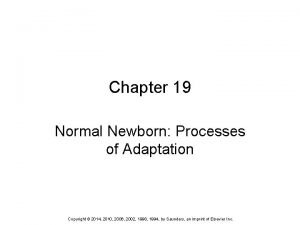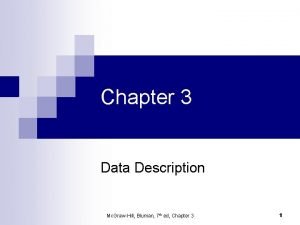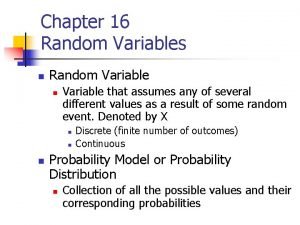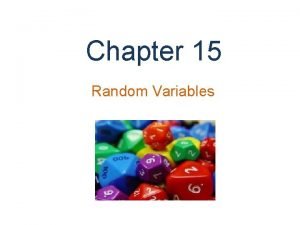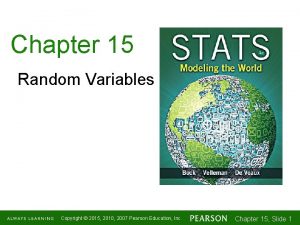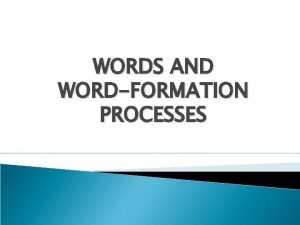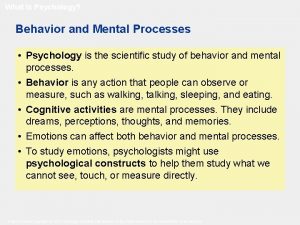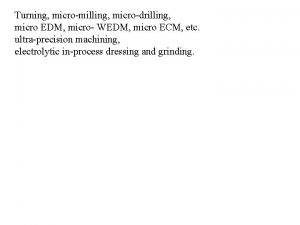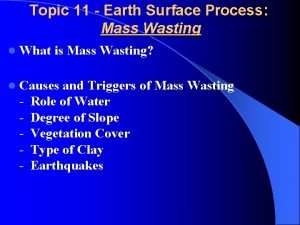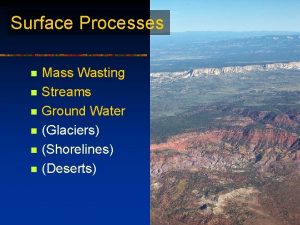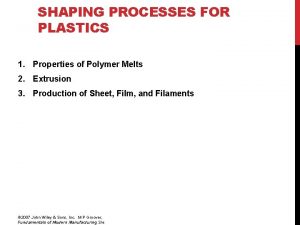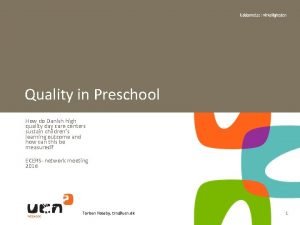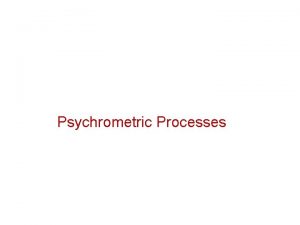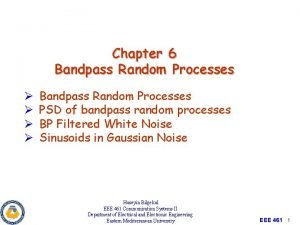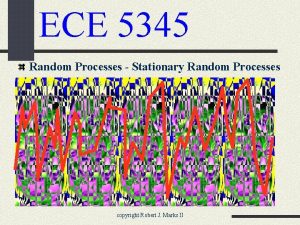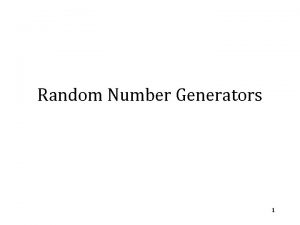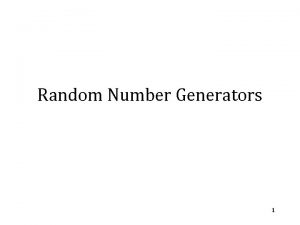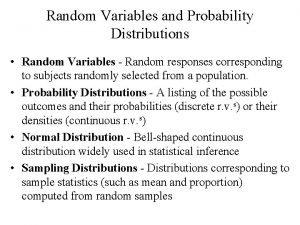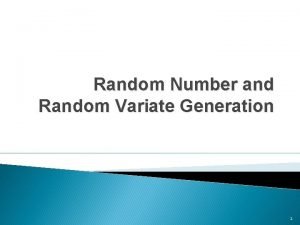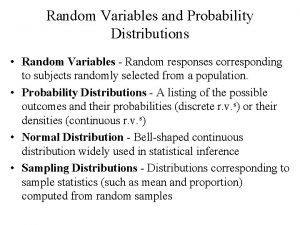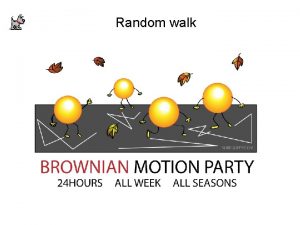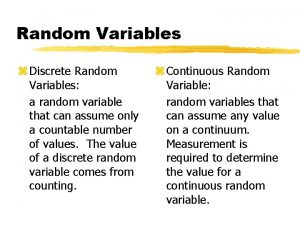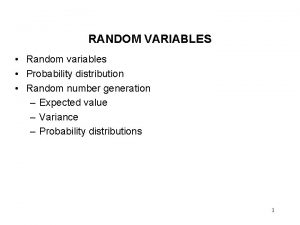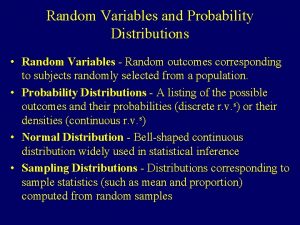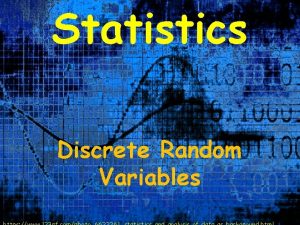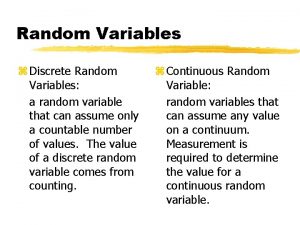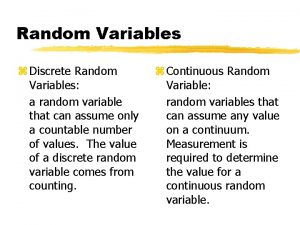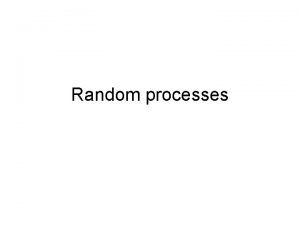Chapter 6 Random Processes Description of Random Processes



























- Slides: 27

Chapter 6 Random Processes Ø Ø Description of Random Processes Stationarity and ergodicty Autocorrelation of Random Processes Properties of autocorrelation Huseyin Bilgekul EEE 461 Communication Systems II Department of Electrical and Electronic Engineering Eastern Mediterranean University EEE 461 1

Homework Assignments • Return date: November 8, 2005. • Assignments: Problem 6 -2 Problem 6 -3 Problem 6 -6 Problem 6 -10 Problem 6 -11 EEE 461 2

Random Processes • A RANDOM VARIABLE X, is a rule for assigning to every outcome, w, of an experiment a number X(w). – Note: X denotes a random variable and X(w) denotes a particular value. • A RANDOM PROCESS X(t) is a rule for assigning to every w, a function X(t, w). – Note: for notational simplicity we often omit the dependence on w. EEE 461 3

Ensemble of Sample Functions The set of all possible functions is called the ENSEMBLE. EEE 461 4

Random Processes • A general Random or Stochastic Process can be described as: – Collection of time functions (signals) corresponding to various outcomes of random experiments. – Collection of random variables observed at different times. • Examples of random processes in communications: – Channel noise, – Information generated by a source, – Interference. t 1 t 2 EEE 461 5

EEE 461 6

EEE 461 7

Collection of Time Functions • Consider the time-varying function representing a random process where wi represents an outcome of a random event. • Example: – a box has infinitely many resistors (i=1, 2, . . . ) of same resistance R. – Let wi be event that the ith resistor has been picked up from the box – Let v(t, wi) represent the voltage of thermal noise measured on this resistor. EEE 461 8

Collection of Random Variables • For a particular time t=to the value x(to, wi) is a random variable. • To describe a random process we can use collection of random variables {x(to, w 1) , x(to, w 2) , x(to, w 3) , . . . }. • Type: a random processes can be either discrete-time or continuoustime. • Probability of obtaining a sample function of a RP that passes through the following set of windows. Probability of a joint event. EEE 461 9

Description of Random Processes • Analytical description: X(t) =f(t, w) where w is an outcome of a random event. • Statistical description: For any integer N and any choice of (t 1, t 2, . . . , t. N) the joint pdf of {X(t 1), X( t 2), . . . , X( t. N) } is known. To describe the random process completely the PDF f(x) is required. EEE 461 10

Example: Analytical Description • Let where q is a random variable uniformly distributed on [0, 2 p]. • Complete statistical description of X(to) is: – Introduce – Then, we need to transform from y to x: – We need both y 1 and y 2 because for a given x the equation x=A cos (y) has two solutions in [0, 2 p]. EEE 461 11

Analytical (continued) • Note x and y are actual values of the random variables X and Y. • Since and p. Y is uniform in [2 pf 0 t 0, 2 pf 0 t 0 + 2 p], we get • Using the analytical description of X(t), we obtained its statistical description at any time t. EEE 461 12

Example: Statistical Description • Suppose a random process x(t) has the property that for any N and (t 0, t 1, . . . , t. N) the joint density function of {x(ti)} is a jointly distributed Gaussian vector with zero mean and covariance • This gives complete statistical description of the random process x(t). EEE 461 13

Activity: Ensembles • Consider the random process: x(t)=At+B • Draw ensembles of the waveforms: – B is constant, A is uniformly distributed between [-1, 1] – A is constant, B is uniformly distributed between [0, 2] • Does having an “Ensemble” of waveforms give you a better picture of how the system performs? x(t) 2 B t t Slope Random B intersect is Random EEE 461 14

Stationarity • Definition: A random process is STATIONARY to the order N if for any t 1, t 2, . . . , t. N, fx{x(t 1), x(t 2), . . . x(t. N)}=fx{x(t 1+t 0), x(t 2+t 0), . . . , x(t. N +t 0)} • This means that the process behaves similarly (follows the same PDF) regardless of when you measure it. • A random process is said to be STRICTLY STATIONARY if it is stationary to the order of N→∞. • Is the random process from the coin tossing experiment stationary? EEE 461 15

Illustration of Stationarity Time functions pass through the corresponding windows at different times with the same probability. EEE 461 16

Example of First-Order Stationarity • Assume that A and w 0 are constants; q 0 is a uniformly distributed RV from [-p, p); t is time. • From last lecture, recall that the PDF of x(t): • Note: there is NO dependence on time, the PDF is not a function of t. • The RP is STATIONARY. EEE 461 17

Non-Stationary Example • Now assume that A, q 0 and w 0 are constants; t is time. • Value of x(t) is always known for any time with a probability of 1. Thus the first order PDF of x(t) is • Note: The PDF depends on time, so it is NONSTATIONARY. EEE 461 18

Ergodic Processes • Definition: A random process is ERGODIC if all time averages of any sample function are equal to the corresponding ensemble averages (expectations) • Example, for ergodic processes, can use ensemble statistics to compute DC values and RMS values • Ergodic processes are always stationary; Stationary processes are not necessarily ergodic EEE 461 19

Example: Ergodic Process • A and w 0 are constants; q 0 is a uniformly distributed RV from [-p, p); t is time. • Mean (Ensemble statistics) • Variance EEE 461 20

Example: Ergodic Process • Mean (Time Average) T is large • Variance • The ensemble and time averages are the same, so the process is ERGODIC EEE 461 21

EXERCISE • Write down the definition of : – Wide sense stationary – Ergodic processes • How do these concepts relate to each other? • Consider: x(t) = K; K is uniformly distributed between [-1, 1] – WSS? – Ergodic? EEE 461 22

Autocorrelation of Random Process • The Autocorrelation function of a real random process x(t) at two times is: EEE 461 23

Wide-sense Stationary • A random process that is stationary to order 2 or greater is Wide -Sense Stationary: • A random process is Wide-Sense Stationary if: • Usually, t 1=t and t 2=t+t so that t 2 - t 1 =t. • Wide-sense stationary process does not DRIFT with time. • Autocorrelation depends only on the time gap but not where the time difference is. • Autocorrelation gives idea about the frequency response of the RP. EEE 461 24

Autocorrelation Function of RP • Properties of the autocorrelation function of wide-sense stationary processes Autocorrelation of slowly and rapidly fluctuating random processes. EEE 461 25

Cross Correlations of RP • Cross Correlation of two RP x(t) and y(t) is defined similarly as: • If x(t) and y(t) are Jointly Stationary processes, • If the RP’s are jointly ERGODIC, EEE 461 26

Cross Correlation Properties of Jointly Stationary RP’s • Some properties of cross-correlation functions are • Uncorrelated: • Orthogonal: • Independent: if x(t 1) and y(t 2) are independent (joint distribution is product of individual distributions) EEE 461 27
 Concurrent processes are processes that
Concurrent processes are processes that Random assignment vs random sampling
Random assignment vs random sampling Random assignment vs random selection
Random assignment vs random selection Chapter 19 normal newborn processes of adaptation
Chapter 19 normal newborn processes of adaptation How to designing and managing service processes
How to designing and managing service processes Summary to kill a mockingbird chapter 1
Summary to kill a mockingbird chapter 1 Chapter 3 data description
Chapter 3 data description Jem walks scout to school
Jem walks scout to school Chapter 16 random variables
Chapter 16 random variables Chapter 15 random variables
Chapter 15 random variables Chapter 15 random variables
Chapter 15 random variables 321 riq
321 riq Word formation processes examples
Word formation processes examples Study of behavior and mental processes
Study of behavior and mental processes Reading processes
Reading processes Subaerial processes
Subaerial processes Examples of sub aerial processes
Examples of sub aerial processes Biological weathering
Biological weathering Micro machining processes
Micro machining processes Mass wasting processes
Mass wasting processes Wharton risk management and decision processes center
Wharton risk management and decision processes center What are the 7 hr processes?
What are the 7 hr processes? Mass wasting processes
Mass wasting processes Arytnoids
Arytnoids Shaping processes for plastics
Shaping processes for plastics Proximal processes
Proximal processes Generic administrative and management functions
Generic administrative and management functions Air washer psychrometric process
Air washer psychrometric process



